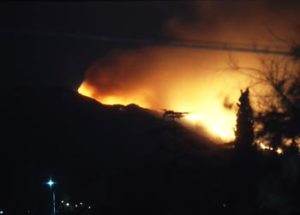Fire Safety
If you haven’t already, please add the app, Watch Duty to your phone. It will notify you of the fires in our area. It has been a wonderful help during the fires of January 2025. You can turn off notifications for any ongoing fire when you wish. It is free.
Community Fire Safety
Website for all LAFD Brush Clearance Information
Some areas are in a Very High Severity Fire Zone. Most of us are in the High Severity Fire Zone in Glencrest Hills. If you are in this area, you are required to keep your property clear of brush and obey the LAFD brush clearance rules. Please go to the LAFD Brush Clearance Information Page.
If one of your neighbors is not clearing brush from their property, it endangers the entire neighborhood. Report a problem brush clearnance area to the LAFD. You may call 800.994.4444 or email LAFDBrush@lacity.org. Make sure you have the address of the problem area.
Find a list of Brush Management Contractors here.
Some of us are unable to deal with the steep slopes and large trees on our property and therefore must hire these services. Here are just a few that are available as posted on the LAFD website (though none are endorsed by them,) but you can do a web search or ask your neighbors who they use.
Cal Fire Website – Great information!
Home Fire Safety
Most importantly you should have 3 things in your home for fire safety,
- Fire extinguishers (the A-B-C extinguisher for homes) on at least every level
- Smoke detectors on every level as well as carbon monoxide detectors (it is the law!)
- Escape plan (see E.D.I.T.H. below) that you practice twice a year.
Here is a local vendor who will come to your house to either recharge your extinguishers, or sell you a new one:
Star Fire Extinguisher Company
280 East Palm Ave.
Burbank, CA
818-840-8555
Even though extinguishers come in a number of shapes and sizes, they all operate in a similar manner. Here’s an easy acronym for fire extinguisher use: P A S S – Pull, Aim, Squeeze and Sweep
PULL– Pull the pin at the top of the extinguisher that keeps the handle from being accidentally pressed.
AIM– Aim the nozzle toward the base of the fire.
SQUEEZE-Stand approximately 8 feet away from the fire and squeeze the handle to discharge the extinguisher. If you release the handle, the discharge will stop.
SWEEP– Sweep the nozzle back and forth at the base of the fire. After the fire appears to be out, watch it carefully since it may re-ignite!
Different Fires & Extinguishers
 |
Class A extinguishers put out fires in ordinary combustible materials such as cloth, wood, rubber, paper, and many plastics. |  |
 |
Class B extinguishers are used on fires involving flammable liquids, such as grease, gasoline, oil, and oil-based paints. |  |
 |
Class C extinguishers are suitable for use on fires involving appliances, tools, or other equipment that is electrically energized or plugged in. |  |
 |
Class D extinguishers are designed for use on flammable metals and are often specific for the type of metal in question. These are typically found only in factories working with these metals. |  |
 |
Class K fire extinguishers are intended for use on fires that involve vegetable oils, animal oils, or fats in cooking appliances. These extinguishers are generally found in commercial kitchens, such as those found in restaurants, cafeterias, and caterers. Class K extinguishers are now finding their way into the residential market for use in kitchens. |  |
For the HOME, the best type to get is an A-B-C extinguisher. Make certain that it is a good extinguisher as some small ones may not fire when you most need them.
Only use a fire extinguisher when:
- You have alerted other occupants and someone has called the fire department;
- The fire is small and contained to a single object, such as a wastebasket;
- You are safe from the toxic smoke produced by the fire;
- You have a means of escape identified and the fire is not between you and the escape route; and
- Your instincts tell you that it is safe to use an extinguisher.
Maintenance of the Extinguisher-Make Certain:
- The extinguisher is not blocked by furniture, doorways, or any thing that might limit access in an emergency. Think of the placement of your extinguishers. If the kitchen extinguisher is near the stove & there is a fire, will you be able to access it? Maybe just outside the kitchen might be better.
- The pressure is at the recommended level. Some extinguishers have gauges that indicate when the pressure is too high or too low.
- All parts are operable and not damaged or restricted in any way. Make sure hoses and nozzles are free of insects or debris. There should not be any signs of damage or abuse, such as dents or rust, on the extinguisher.
- The outside of the extinguisher is clean. Remove any oil or grease that might accumulate on the exterior.
- Shake dry chemical extinguishers once a month to prevent the powder from settling or packing. Check the manufacturer’s recommendations.
- Have your extinguisher inspected once every 5 years.
Here are some excellent publications put out by the LAFD. Just click the title and it will automatically download to your computer.
- 10 Of THE BEST Fire Prevention Tips (great to review with your children!)
- E.D.I.T.H. (Exit Drills In The Home)
- Fire Escape Plan Grid
- About Smoke Detectors
- Home Fire Safety Tips
- Household Haz-Mat Disposal Tips
- Holiday Fire Prevention
- Candle Safety (after an earthquake, DO NOT use candles. They can tip over and set fire to your home in the event of an after-shock!)
- Storm Safety



